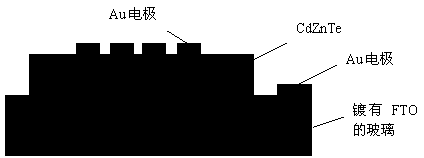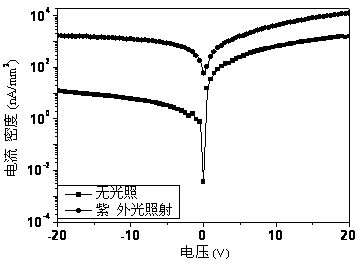Preparation method of CdZnTe thin-film ultraviolet light detector
A technology of ultraviolet light and detectors, applied in semiconductor devices, final product manufacturing, sustainable manufacturing/processing, etc., to achieve low cost, improve device responsivity, and control device leakage current effects
- Summary
- Abstract
- Description
- Claims
- Application Information
AI Technical Summary
Problems solved by technology
Method used
Image
Examples
Embodiment 1
[0025] The preparation process and steps of this embodiment are as follows:
[0026] (a) Preparation of the sublimation source: According to the known prior art, under high vacuum, high-purity Cd, Zn, Te simple substances are transformed from liquid to solid at a crystallization point in the temperature gradient region of the Bridgman furnace, CdZnTe crystals with good quality, relatively uniform composition distribution, and a zinc molar content of 5% were grown, and sliced as a sublimation source;
[0027] (b) Substrate pretreatment: use glass coated with a transparent conductive layer FTO as the substrate, and ultrasonically clean the substrate with deionized water, acetone and ethanol for 15 minutes respectively to remove impurities and organic substances on the surface, dry and put Into the close space sublimation reaction chamber;
[0028] (c) Growth process: Turn on the mechanical pump to evacuate the sublimation chamber to below 3Pa, then turn off the mechanical...
Embodiment 2
[0032] The preparation process and steps of this embodiment are as follows:
[0033] (a) Preparation of the sublimation source: According to the known prior art, under high vacuum, high-purity Cd, Zn, Te simple substances are transformed from liquid to solid at a crystallization point in the temperature gradient region of the Bridgman furnace, CdZnTe crystals with good quality, relatively uniform composition distribution, and a zinc molar content of 5% were grown, and sliced as a sublimation source;
[0034] (b) Substrate pretreatment: use glass coated with a transparent conductive layer FTO as the substrate, and ultrasonically clean the substrate with deionized water, acetone and ethanol for 15 minutes respectively to remove impurities and organic substances on the surface, dry and put Enter the close-space sublimation reaction chamber.
[0035] (c) Growth process: Turn on the mechanical pump to evacuate the sublimation chamber to below 3Pa, then turn off the mechanica...
Embodiment 3
[0039] The preparation process and steps of this embodiment are as follows:
[0040] (a) Preparation of the sublimation source: According to the known prior art, under high vacuum, high-purity Cd, Zn, Te simple substances are transformed from liquid to solid at a crystallization point in the temperature gradient region of the Bridgman furnace, CdZnTe crystals with good quality, relatively uniform composition distribution, and a zinc molar content of 5% were grown, and sliced as a sublimation source;
[0041] (b) Substrate pretreatment: use glass coated with a transparent conductive layer FTO as the substrate, and ultrasonically clean the substrate with deionized water, acetone and ethanol for 15 minutes respectively to remove impurities and organic substances on the surface, dry and put Enter the close-space sublimation reaction chamber.
[0042] (c) Growth process: Turn on the mechanical pump to evacuate the sublimation chamber to below 3Pa, then turn off the mechanica...
PUM
 Login to View More
Login to View More Abstract
Description
Claims
Application Information
 Login to View More
Login to View More - R&D
- Intellectual Property
- Life Sciences
- Materials
- Tech Scout
- Unparalleled Data Quality
- Higher Quality Content
- 60% Fewer Hallucinations
Browse by: Latest US Patents, China's latest patents, Technical Efficacy Thesaurus, Application Domain, Technology Topic, Popular Technical Reports.
© 2025 PatSnap. All rights reserved.Legal|Privacy policy|Modern Slavery Act Transparency Statement|Sitemap|About US| Contact US: help@patsnap.com



